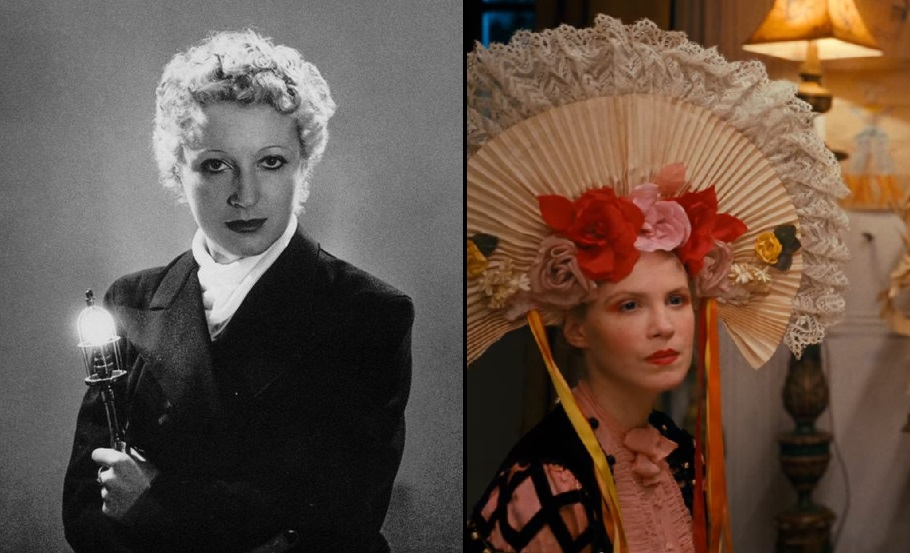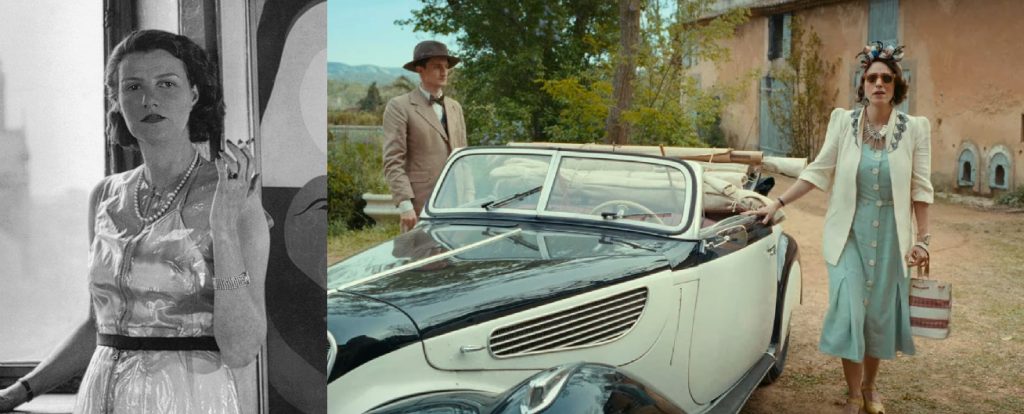Art on Screen: 12 Movies about Artists Worth Seeing
Whether troubled or exciting, extraordinary or perfectly average, the lives of artists are an endless source of inspiration for cinematographers.
Edoardo Cesarino 17 February 2025
25 January 2024 min Read
During WWII the American team Emergency Rescue Committee (ERC) led by Varian Fry rescued more than 2,000 people from the Nazi regime between 1940 and 1941. Among them were some of the most renowned modernist artists whose art was considered “degenerate”. Thanks to ERC and diplomats like Hiram “Harry” Bingham, they traveled legally to the United States. In April 2023, Netflix premiered a limited series Transatlantic, based on the novel The Flight Portfolio by Julie Orringer. In it we see André Breton, Jacqueline Lamba, Marc Chagall, and others waiting to escape Marseille. Not everyone was Jewish, but all of them were “degenerate” artists. Let’s take a quick look at some of the artists that appear in the show.

Official poster for Netflix’s Transatlantic. IMDb.
André Breton (1896-1966) was a member of the Dadaists before he turned to Surrealism. In 1924, he wrote the Surrealist Manifesto and defined the movement as “psychic automatism”. He is a prominent character in the show and in episode 3, during Max Ernst’s birthday party, he wears one of Man Ray’s famous masks.

Left: Man Ray, André Breton, 1930. Wikiart. Right: Art reference to Man Ray’s André Breton in Transatlantic, S1E03. Transatlantic/Netflix.
Jaqueline Lamba (1910-1993) was another French Surrealist artist and also a member of the French Communist Party. She was amazed by Breton’s words which inspired her to join the Surrealist movement. They were even married from 1934 to 1943, and they had a child together, Aube.

Left: Man Ray, Jaqueline Lamba, 1930, Heroínas. Right: Art reference to Jaqueline Breton in Transatlantic, S1E03. Transatlantic/Netflix.
In Transatlantic they both met with Varian Fry in Villa Air-Bel, on the outskirts of Marseilles. They stayed there until Vice Consul Hiram “Harry” Bingham got their visas to travel safely on a ship from Marseilles to the US. In reality, they went over the Pyrenees first. In the still below, we see Lamba reading her Tarot cards to Varian Fry.

Art reference to Jaqueline Breton’s tarot cards in Transatlantic, S1E03. Transatlantic/Netflix.
Max Ernst (1891- 1976) was a German avant-garde artist. He was forced to participate in WWI and the trauma he experienced led him to the Dadaist and Surrealist groups. A couple of his paintings were on display in Hitler’s Degenerate Art Exhibition in 1937. The Surrealist party in episode three is in Ernst’s honor and his outfit in it reflects his passion for birds. The show mentions the Museum of Modern Art (MOMA) as the institution pushing the US to get him an emergency visa from the Consulate in Marseilles.

Left: Max Ernst. Christie’s. Detail. Right: Art reference to Max Ernst in Transatlantic, S1E03. Transatlantic/Netflix.
Luise Straus-Ernst (1993-1944) was an art historian, writer, journalist, and artist. She came from a Jewish family and as such she had to flee Germany. She arrived in Paris, but after the Nazi occupation she tried to leave. As an artist, she often used the alias Armada von Duldgedalzen. In the photo on the left, we see her with her and Ernst’s son, Jimmy, who later became a painter, too.
Transatlantic only portrays her as Max Ernst’s ex-wife, with whom he was married from 1918 until 1927. The show mentions that the US granted her and Ernst a visa to go. In reality, Straus never left Europe and in 1943 she was arrested, deported, and taken to Auschwitz where she was executed.
![Transatlantic: Left: August Sander, Mother and Son [Lou Straus-Ernst with son Jimmy], 1928, Museum of Modern Art, New York, NY, USA. Right: Art reference to Luise Straus-Ernst in Transatlantic, S1E03. Transatlantic/Netflix.](https://www.dailyartmagazine.com/wp-content/uploads/2023/04/Luise-Straus-1024x660.png)
Left: August Sander, Mother and Son [Lou Straus-Ernst with son Jimmy], 1928, Museum of Modern Art, New York, NY, USA. Right: Art reference to Luise Straus-Ernst in Transatlantic, S1E03. Transatlantic/Netflix.
Marc Chagall (1887-1985) was a Russian-French and Jewish artist. Both his art and faith made him a primary target of the Nazis. Once again, the MOMA interceded and requested an emergency visa for Chagall and his wife, Bella, which took too long to arrive. Bingham had to give them one even without checking all the requirements. The show alters the details of their visa situation, but it is true that Marc and Bella Chagall refused to leave France, even as Fry and Bingham repeatedly asked them to. In the end, they left safely with legal documents to ensure their stay in the US.

Left: Marc and Bella Chagall. MASTERWORKS. Right: Art reference to Marc and Bella Chagall in Transatlantic, S1E07. Transatlantic/Netflix.
Marcel Duchamp (1887-1968) was a French artist who experimented with Dadaism, Surrealism, and conceptual art. His ready-made Fountain was a pivotal point in the history of Western art. It is no surprise that Duchamp’s avant-garde art was deeply hated by the Nazi regime. In Transatlantic, he appears briefly in episode 3, also during the party.

Left: Marcel Duchamp. Wikipedia Commons. Right: Art reference to Marcel Duchamp in Transatlantic, S1E03. Transatlantic/Netflix.
Victor Brauner (1903-1966) was a Romanian-Jewish Surrealist artist. After spending time in France, he returned to his country and joined the Communist Party. He was a member of the Dadaists, the Abstractionists, and the Expressionists. He has a minor role in the show, and in fact, he could not travel to the US. According to Transatlantic, the US was not yet issuing visas for Romanians. In real life, Brauner escaped to Switzerland. He never left Europe, but he managed to survive WWII. The image on the left shows him enjoying the afternoon with the rest of the refugees in Villa Air-Bel.

Left: Jacqueline Lamba Breton and Victor Brauner sit outside on a bench at the Villa Air-Bel on a snowy day, United States Holocaust Memorial Museum, Washington D.C., USA. United States Holocaust Memorial Museum. Right: Art reference to Victor Brauner in Transatlantic, S1E03. Transatlantic/Netflix.
Another German artist, Hans Bellmer (1902-1975) had a career in Berlin until the Nazis took over. He voluntarily stopped working as an illustrator and book printer to show resistance. Then, he fled to Paris and later to Marseille. Bellmer’s most famous works are a series of dolls arranged in different positions, sometimes erotic or mutilated. In the show he appears working with some dolls, alluding to his artworks.

Left: Hans Bellmer. ManRay. Right: Art reference to Hans Bellmer in Transatlantic, S1E05. Transatlantic/Netflix.
Bill Freier’s real name was Wilhelm Spira (1913-1999). He was a Jewish cartoonist. In the show, he helps the ERC by forging documents for refugees. In real life, he did not escape Europe and was taken to concentration camps. Thankfully, he survived and lived a long life.

Left: Bill Freier (Willi Spira) works at a small table easel in an unidentified French internment camp, United States Holocaust Memorial Museum, Washington D.C., USA. United States Holocaust Memorial Museum. Right: Art reference to Hans Bellmer in Transatlantic, S1E07. Transatlantic/Netflix.
No, Peggy Guggenheim was not an artist. However, she was an extremely wealthy art collector who had to flee the Nazis for being Jewish. Transatlantic has her telling the story of how the Louvre refused to store her collection and the only way to get it out of Europe was as “household goods”. In any case, Guggenheim collected contemporary art from avant-garde artists and in the hands of the Nazis, her collection could have been destroyed for being “degenerate”. Guggenheim also organized exhibitions that helped many artists gain notoriety. Moreover, the show teases her future marriage to Max Ernst which happened when they were in America in December of 1941.

Left: Peggy Guggenheim, Paris, c.1930. Photograph by Rogi André (Rosza Klein) Detail. Right: Art reference to Peggy Guggenheim in Transatlantic, S1E03. Transatlantic/Netflix.
In the series we see the artists interacting, giving opinions about art and life, and just having fun in their very particular ways. However we also see them extremely conscious of the situation in all of Europe as they express their ideas and feelings. In the meantime, Villa Air-Bel served as a haven for these artists and, at least in the show, they enjoyed themselves if only for some time before fleeing Europe.

Art reference to a Surrealist game in Transatlantic, S1E06. Transatlantic/Netflix.
Lastly, Although Varian Fry had a list of notable artists to save, he also helped intellectuals and writers, such as Hannah Arendt, Walter Mehring, and Benjamin Walker. Moreover, hundreds of people who did not meet the requirements got their visas thanks to the ERC. Fry was also helped by an extraordinary group of people who risked their fortunes, jobs, and lives to help in whatever way they could. Among them, the heiress Mary Jayne Gold contributed by financing the operations, while Albert Hirschman and Lisa Fittko helped take people out of France.
DailyArt Magazine needs your support. Every contribution, however big or small, is very valuable for our future. Thanks to it, we will be able to sustain and grow the Magazine. Thank you for your help!